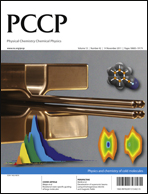We report the spectroscopic characterization of excited electronic states of KRb by combining spectra from molecular beam (MB) experiments with those from ultracold molecules (UM) formed by photoassociation (PA) of ultracold atoms. Spectra involving the 11Π, 23Σ+, and b3Π states in a strongly perturbed region have been identified. This approach provides a powerful method to identify the vibrational levels of the excited electronic states perturbed globally by neighboring electronic states. This is because the two sets of spectra from the UM and the MB experiments probe the same energy region from very different initial electronic states. The UM experiments utilize high v′′ levels of the a3Σ+ state with large internuclear separations, while the MB experiments utilize low v′′ levels of the ground X1Σ+ state with near-equilibrium internuclear separations. Only the Ω = 1 levels of the 23Σ+ and b3Π states are observed in the MB spectra, while the Ω = 0−, 1 levels of the 23Σ+ state and the Ω = 0±, 1, 2 levels of the b3Π state are observed in the UM spectra.

You have access to this article
 Please wait while we load your content...
Something went wrong. Try again?
Please wait while we load your content...
Something went wrong. Try again?


 Please wait while we load your content...
Please wait while we load your content...